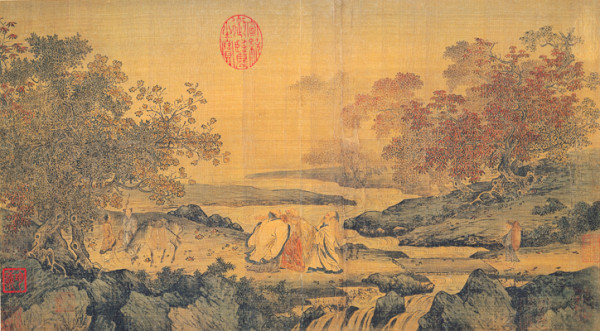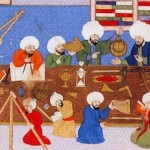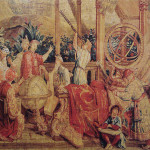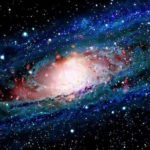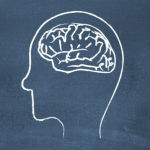The Stillbirth of Science in China
by Dr. Stacy Trasancos
Filed under Christianity and Science
NOTE: Today we're continuing our weekly series of essays by Dr. Stacy Trasancos on the "stillbirths" of science. They're based on Fr. Stanley L. Jaki's research into the theological history of science in the ancient cultures of Egypt, China, India, Babylon, Greece, and Arabia. See past articles here.
There is so much written about China’s rich and illustrious past that no case could ever be made—from the Shang Dynasty (1523–1028 B.C.) to the Ch’ing Dynasty (A.D. 1644–1912)—that there was no progress in civilization, art, or literature. Likewise, volumes have been written on the question of the history of science and Chinese civilization. In Science and Creation: From Eternal Cycles to an Oscillating Universe and The Savior of Science (pages 46 and 35 respectively), Jaki referred to the extensive research of British biochemist Joseph Needham. In seven volumes comprised of twenty-seven books, Needham and his team of international collaborators reviewed the history of science and technology in China. The massive work was eventually published by the Cambridge University Press under the title Science and Civilisation in China; and the project, which began in 1954, continues to the present day.
A brief overview of the content of these volumes will demonstrate the extent of cultural development in China and the futility of ignoring such a rich history. Needham’s first volume (1954) is an introduction to the rest of the work. Volume Two (1956) covers the history of scientific thought in China, including the organic naturalism of the great Taoist school, the scientific philosophy of the Mohists and Logicians, and the quantitative materialism of the Legalists. Volume Three and the three-part Volume Four (1959–1971) addresses mathematics and the sciences of the heavens and earth, physics, mechanical engineering, civil engineering, and nautics. Volume Five (1985–1999) has thirteen parts: the first on paper and printing; the second through the fifth on spagyrical discovery and inventions including gold and immortality, cinnabar elixirs, synthetic insulin, apparatus, and physiological alchemy; the sixth and seventh on military technology from missiles and sieges to the “gunpowder epic;” the ninth on the textile industry while the eighth and tenth are still works in progress; the eleventh on ferrous metallurgy; the twelfth on ceramic technology; and the thirteenth on mining. Volume Six (1986–2000) deals with botany, agriculture, agroindustry, and forestry in the first three parts and fermentations, food science, and medicine in the fifth and sixth parts, while the fourth part of Volume Six is still in progress. Finally, Volume Seven (1998–2004) covers language and logic, and then gives the general conclusions and reflections. (See full list here.) The purpose of listing these volumes published over a span of six decades is to demonstrate that intensive work has been devoted to the history of science in China, and Jaki was aware of this. He acknowledged it in the development of the “stillbirths” argument.
In Science and Creation (pages 30-32) Jaki discussed how around 350 B.C., the astronomer Shih Shen drew up a catalogue of around 800 stars and how the manuscripts were stored in the Imperial Library. The ability to catalogue and store documents displayed great sophistication. Technological improvements were made in water works and the extension of the Great Wall, a massive achievement. During the three and a half centuries known as the age of the Warring States (480–220 B.C.), cultural growth continued. The Chinese invented the waterwheel, the wheelbarrow, and other devices that demonstrated continued technological development. Around the middle of the fourth century, Hu Hsi made observations that led him to discover the precession of equinoxes, although the Greek scholar Hipparchus is credited with discovering it centuries earlier.
The peak periods of Chinese culture spanned the Han, Sung, Thang, Yuan, and Ming periods (collectively 202 B.C.– A.D. 1644) and represented a length of time when scientific endeavor could have “received a decisive spark.” There were technological feats in which the Chinese were the “sole inventors” for a number of centuries. They invented the effective use of horses, the foot-stirrup and breast-strap harness. They discovered magnetic ore. They invented the revolutionary skill of paper-making, which led to the production of printed books. They invented the process of making gunpowder, the production of porcelain, and the development of water-driven mechanical clocks. They used magnets for travel and moveable clay types for printing.
The Chinese also, Jaki noted, developed algebra at a level compatible with the best in Europe around A.D. 1250. According to Francis Bacon, printing, gunpowder, and magnets were the factors that ushered in the age of science more than anything, but Jaki challenged Bacon’s assertion by noting that even with these developments the Chinese “remained hopelessly removed from the stage of sustained, systematic scientific research.”
The Chinese had rockets for centuries but did not investigate trajectories or free fall. Their ability to print books did not lead to a “major intellectual ferment.” Magnets were installed on their ships and they were the best navy in the world for the fourteenth and fifteenth centuries, but they never circumnavigated the globe.
Historians have also noted that the “Industrial Revolution” did not originate in China, and that is of great significance for Jaki’s argument that science was “stillborn” in Chinese culture. Jaki cited a 1922 article in The International Journal of Ethics entitled “Why China Has No Science: An Interpretation of the History and Consequences of Chinese Philosophy." The author, Yu-Lan Fung, who contributed to Needham’s volumes, noted that the history of Europe and the history of China before the Renaissance are “on the same level,” by which he meant that they both progressed at about the same pace, albeit in different ways. After that time the pace differed: “China is still old while the Western countries are already new.” Fung asked, “What keeps China back?” He answered that it is because “she has no science . . . because according to her own standard of value she does not need any . . . China has not discovered the scientific method, because Chinese thought started from mind, and from one’s own mind.” If truth and knowledge are in the mind, separated from the external world, there is no need for scientific investigation beyond practical skill.
Fung contrasted the three major powers which competed to conquer the entire empire of China from 570 B.C. to about 275 B.C–Taoism, Moism, and Confucianism. Taoism taught a “return to nature” with nature being the natural state of all things, including the natural tendency of man toward vice. According to Taoism, “every kind of human virtue and social regulation is to them against nature.” Knowledge was considered to be of no use because the Tao is inside man, as the god of the pantheistic philosophy. Taoism did not require any questioning of a beginning and an end, about final purposes and goals, or about the controlling of the forces and patterns in the workings of the Yin and Yang. The cosmological passage from the Chuang Tzu demonstrated this mindset:
"Men who study the Tao do not follow on when these operations [properties belonging to things] end, nor try to search out how they began: - with this all discussion of them stops." Texts of Taoism, translated by J. Legge (New York: Julian Press, 1959), Book XXV, par. 11, 568-69; quoted in Jaki, Science and Creation, 30.
The key to success in Taoism was to merge into the rhythm of cosmic cycles.
The fundamental idea of Moism was “utility,” and virtue was seen as useful. Universal love was taught as a doctrine for the benefit of the country and people, and progress was the ideal of mutual help; anything that was incompatible with the increase of wealth and population was to be fought against. Confucius stood between the two, emphasizing discrimination in different situations. He taught that human nature is essentially good although men are not born perfect. To become perfect, the innate reason must be developed and lower desires “wholly taken away.” His concerns were ethical, not metaphysical. Therefore, Confucius taught that the individual should seek what is in himself and leave external things to their natural destiny.
In these competing theories of existence, the power that governs the universe is the omnipotent Tao for Taoism, the personified self-god in Moism, and Heavenly Reason according to Confucianism. Moism did have a notion of Heaven as personal and caring for humans, a monotheism of sorts, but its ethics were severed from this idea. As these powers competed over time, to put it far too concisely to do the history enough justice, they actually merged and philosophical investigation of “things” gave rise to two forms of Neo-Confucianism, one school that sought “things” externally and another that sought “things” as phenomena in the mind. In Medieval Europe the same ideas about “things” more or less existed too, but from there on, China and Europe diverged:
"In other words, Medieval Europe under Christianity tried to know God and prayed for His help; Greece tried, and Modern Europe is trying to know nature and to conquer, to control it; but China tried to know what is within ourselves, and to find there perpetual peace." (Fung, "Why China Has No Science")
So China did not have use for the scientific method because the religions sought what is in the mind separate from the external world. Fung concluded his paper with a call for mankind to become wiser and to find peace and happiness by turning attention to Chinese wisdom so that the “mind energy of the Chinese people of four thousand years will yet not have been spent in vain.” Even if modern science was not born in China, there were other aspects of the culture that were worthy of admiration.
In concluding this consideration of China’s history, it needs to be noted that other scholars concurred with Fung. In 1995, Justin Yifu Lin of Peking University published an essay titled “The Needham Puzzle: Why the Industrial Revolution Did Not Originate in China.” Lin noted from evidence documented in Needham’s work that “except for the past two or three centuries, China had a considerable lead over the Western world in most of the major areas of science and technology.” From an economic and social perspective, he considers why, despite early advances in science, technology, and institutions, China did not take the next step in the seventeenth century as Western Europe did.
Ultimately that answer depends on how the Chinese viewed the external world and whether it was created by God or was God itself. In believing that the world was God and was eternal, there was no need to question a beginning and an end or how everything came to be. Needham also acknowledged that it is a theological orientation of Chinese thought that can be singled out as the decisive factor that blocked the attitude conducive to developing a systematic, scientific investigation. (Science and Civilisation in China, 580-582) “There, according to Needham’s admission, all the early cultivators of science drew courage for their pioneering efforts from a belief in a personal and rational Creator.” (Jaki, Science and Creation, 40.)
For the purposes of Jaki’s argument, the similarity of the Egyptian and Chinese cultures bears emphasizing. Both were pantheistic, with some degree of monotheism but still a monotheism that held that the world was God, which is basically pantheism. Neither had a loving Creator who “ordered all things in measure, and number, and weight,” who made man in His image with intellect and free will, or who became Incarnate to redeem mankind. “In a universe without the voice of God there remains no persistent and compelling reason for man to search within nature for distinct voices of law and truth.” (Jaki, Science and Creation, 41.)
Sources:
- Stanley L. Jaki, Science and Creation: From Eternal Cycles to an Oscillating Universe (Edinburgh: Scottish Academic Press, Ltd, 1986).
- Stanley L. Jaki, The Savior of Science (Grand Rapids, MI: William B. Eerdmans Publishing Company, 2000).
- Joseph Needham, Science and Civilisation in China: Volume 2, History of Scientific Thought (Cambridge, UK: Cambridge University Press, 1956).
- Yu-Lan Fung, “Why China Has No Science: An Interpretation of the History and Consequences of Chinese Philosophy,” The International Journal of Ethics, 32 (1922), 237-263.
- Texts of Taoism, translated by J. Legge (New York: Julian Press, 1959).
- Justin Yifu Lin, “The Needham Puzzle: Why the Industrial Revolution Did Not Originate in China,” Economic Development and Cultural Change (University of Chicago Press, 1995), 269-292.
Related Posts
Note: Our goal is to cultivate serious and respectful dialogue. While it's OK to disagree—even encouraged!—any snarky, offensive, or off-topic comments will be deleted. Before commenting please read the Commenting Rules and Tips. If you're having trouble commenting, read the Commenting Instructions.




